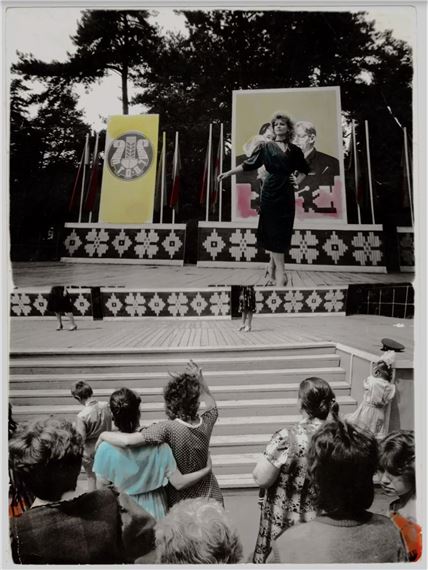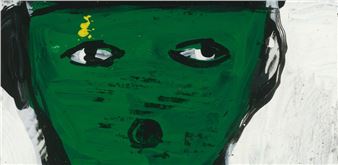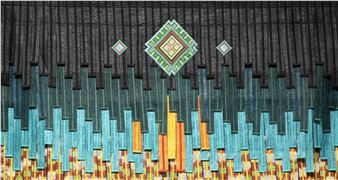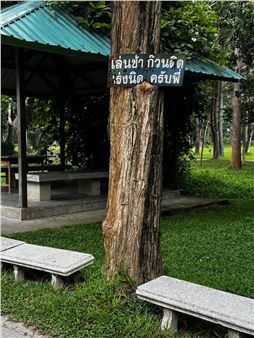Boris Mikhaïlov: Reverse Perspective
A crouching man prepares to dive, as in Alexandre Rodchenko's most dizzying photographs, but there is no swimming pool beneath him. ÔÇ£There was Rodchenko, at the beginning of Sovietism, and me at the end,ÔÇØ1 said Boris Mikha├»lov. The photos remain, and paper and glue, but photocollage may have had its day. Where have the clear grid, the vigorous diagonal, and the colors that follow the momentum of the line gone? And the slogans? And the cutouts in the images? And the factory chimneys, seen from below, gazing into the distance? Rodchenko arrived at the beginning, and Mikha├»lov at the end. Between the two, we see the beginnings of a reluctance to organize graphic space, a refusal to regiment plastic signs, which is to say, also, a desire to let go, to abandon the self. In the series Colored Background (Mikha├»lov, like his elder, works in series), colored paper remainsÔÇöincluding all colors, even the brightestÔÇöas do photographic prints. The prints are glued onto sheets of paper, more or less in the centerÔÇöbut does it matter? Black-and-white is placed on color. It may evoke the pages of a family album that someone wanted to make more cheerful. In places, superimposed planes of color form a kind of base under the photo: it almost looks like the sketch of a Suprematist collage, or even the aborted maquette of an issue of ðíðíðíðá ð¢ð░ ÐüÐéÐÇð¥ð╣ð║ðÁ (USSR in construction), or rather, in this case, USSR in decay. Here, a red stripe cuts across the beige background of an image of an unfinished driveway, on a vast expanse of sand; there, a red rectangle on an ultramarine background supports two women in swimsuits sitting on a crate in the middle of a huge field, its horizon as flat as the one behind which ships disappear; elsewhere, a yellow, red, and green base enhances a pipe that Rodchenko would undoubtedly have preferred to photograph better coiled. With few exceptions, the prints are glued whole. Here, there is no need to tamper with reality by fragmenting it in order to produce a full and unambiguous meaning, as in RodchenkoÔÇÖs constructions, saturated with ideology but devoid of referents. Colored Background depicts only ordinary existence, presented as it is, vulnerable and yet unyielding, sometimes tender, familiar, or ridiculous: the doubtful pout of a man in a cap, small stalls, an individual strolling through a park with his balloons, joyful, naked women. The few cutouts are surprising in this highly connotative space, like the little lady in a headscarf canceling out the transcendence of the suprematist square, or the bather whose spine is enhanced with small colorful touchesÔÇöas fragile and derisory as the bodies and objects they adorn throughout the series. Similar observations could undoubtedly be made about the YesterdayÔÇÖs Sandwich and Dvoyky series, which draw on the achievements of Constructivism, far from the ghosts of the future. How far removed they are from the triumphant superimpositions of El Lissitzky! Instead of the heroic Runner in the City (1926), we see legs covered in bedsores, against a snowy landscape, a solid statue of a socialist realist bather in a frail fence, and then watery, damp still lifes oozing with eros. Rodchenko and Lissitzky arrived at the beginning, and Mikhailov at the end. He moved away from ÔÇ£great things to move towards man, simplicityÔÇØ2: the time for epics is over, make way for life.

Recommended for you
A crouching man prepares to dive, as in Alexandre Rodchenko's most dizzying photographs, but there is no swimming pool beneath him. ÔÇ£There was Rodchenko, at the beginning of Sovietism, and me at the end,ÔÇØ1 said Boris Mikha├»lov. The photos remain, and paper and glue, but photocollage may have had its day. Where have the clear grid, the vigorous diagonal, and the colors that follow the momentum of the line gone? And the slogans? And the cutouts in the images? And the factory chimneys, seen from below, gazing into the distance? Rodchenko arrived at the beginning, and Mikha├»lov at the end. Between the two, we see the beginnings of a reluctance to organize graphic space, a refusal to regiment plastic signs, which is to say, also, a desire to let go, to abandon the self. In the series Colored Background (Mikha├»lov, like his elder, works in series), colored paper remainsÔÇöincluding all colors, even the brightestÔÇöas do photographic prints. The prints are glued onto sheets of paper, more or less in the centerÔÇöbut does it matter? Black-and-white is placed on color. It may evoke the pages of a family album that someone wanted to make more cheerful. In places, superimposed planes of color form a kind of base under the photo: it almost looks like the sketch of a Suprematist collage, or even the aborted maquette of an issue of ðíðíðíðá ð¢ð░ ÐüÐéÐÇð¥ð╣ð║ðÁ (USSR in construction), or rather, in this case, USSR in decay. Here, a red stripe cuts across the beige background of an image of an unfinished driveway, on a vast expanse of sand; there, a red rectangle on an ultramarine background supports two women in swimsuits sitting on a crate in the middle of a huge field, its horizon as flat as the one behind which ships disappear; elsewhere, a yellow, red, and green base enhances a pipe that Rodchenko would undoubtedly have preferred to photograph better coiled. With few exceptions, the prints are glued whole. Here, there is no need to tamper with reality by fragmenting it in order to produce a full and unambiguous meaning, as in RodchenkoÔÇÖs constructions, saturated with ideology but devoid of referents. Colored Background depicts only ordinary existence, presented as it is, vulnerable and yet unyielding, sometimes tender, familiar, or ridiculous: the doubtful pout of a man in a cap, small stalls, an individual strolling through a park with his balloons, joyful, naked women. The few cutouts are surprising in this highly connotative space, like the little lady in a headscarf canceling out the transcendence of the suprematist square, or the bather whose spine is enhanced with small colorful touchesÔÇöas fragile and derisory as the bodies and objects they adorn throughout the series. Similar observations could undoubtedly be made about the YesterdayÔÇÖs Sandwich and Dvoyky series, which draw on the achievements of Constructivism, far from the ghosts of the future. How far removed they are from the triumphant superimpositions of El Lissitzky! Instead of the heroic Runner in the City (1926), we see legs covered in bedsores, against a snowy landscape, a solid statue of a socialist realist bather in a frail fence, and then watery, damp still lifes oozing with eros. Rodchenko and Lissitzky arrived at the beginning, and Mikhailov at the end. He moved away from ÔÇ£great things to move towards man, simplicityÔÇØ2: the time for epics is over, make way for life.

 ARTISTS
ARTISTS
















